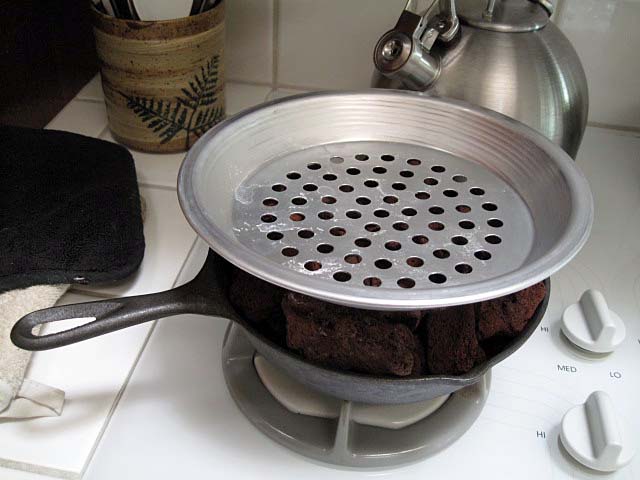On my last two bakes I’ve used the 3-stage Detmolder process from Hamelman’s Bread. I decided I would try to use it with a white sourdough.
3-stage build Stage 1—Freshening
5 hours at ~78ºF. Room temperature in SW Florida.
| KA ap flour | .3 oz | 100% |
| water | .4 oz | 150% |
| mature starter | .1 oz | 50% |
Stage 2—Basic Sour
15 hours at ~78ºF.
| KA ap flour | 3.2 oz | 100% |
| Water | 2.4 oz | 76% |
| stage 1 starter | .8 oz | 24% |
Stage 3—Full Sour
3 hours at ~85ºF. This was achieved using 2 large plastic bins in a stack, with the bottom stack containing 5 inches of water and a submersible aquarium heater.
| KA ap flour | 7.7 oz | 100.0% |
| water | 7.7 oz | 100.0% |
| stage 2 starter | 6.4 oz | 82.6% |
I mixed the Basic Sour at 10:30 P.M. on Friday and by 9:30 A.M. on Saturday it had already fallen. I stirred the starter and watched it closely until I found that it was rising again. It continued rising for the full 15 hours.
The directions call for an autolyse with all ingredients but the salt. In the past I’ve had problems integrating the salt into the dough by hand, so I held back an amount of flour and water from the autolyse. I disolved the salt in the retained water, then made a second dough with just the water, flour, and salt. After the autolyse, the two doughs were incorporated.
AutolyseAutolyse dough
62.5% hydration (figuring on the levain being 100% for 5.5 oz each flour and water)
| KA ap flour | 19.0 oz |
| whole rye | 4.8 oz |
| water | 12.8 oz |
| levain | 11.1 oz |
Salt dough
64% hydration
| KA ap flour | 5.0 oz |
| water | 3.2 oz |
| salt | .6 oz |
Bulk Fermentation
2.5 hours at 78ºF with a single fold at 1:15.
Shaping
I made use of my new bench board from New York Bakers. What an improvement over my hideous counter top! I think far less extra flour was incorporated into my dough, and it was far easier to work with.
I made a concerted effort to not over-work the dough during the pre-shaping and shaping stages. I have a bad tendency to work the dough too much and I think the end result may be a crumb that’s more dense than it should be.
With the loaves shaped into boules, they went into bannetons floured with a mixture of rice flour and ap, into a large plastic bag, and into the refrigerator.
Final Fermentation
The entire final fermentation was conducted in the refrigerator. At 14 hours the loaf closer to the front of the fridge seemed fully proofed, or close to it. The loaf toward the back of the fridge still felt somewhat dense, but I decided to go ahead and start the bake as I’ve never gone straight from fridge to oven before. My concern was that perhaps the proofed loaf was overproofed. I knew one of the two loaves would not be ideal, but hoped that one of them would be good and that I would learn something from the difference between them.
I scored the lesser proofed loaf with straight slashes radiating from aproximately 2–3 inches from center. The more fully proofed loaf was scored with arcing slashes radiating from the center. I’ve used this cut before on boules, but it proved to be an unfortunate choice.
Bake
The target bake temperature is 460ºF, so I headted the oven to 500ºF, with my new cordierite bake stone (also from New York Bakers), and my trusty rusty cast iron skillet on the bottom.
I steamed the oven with boiling water, misted the loaves, and loaded them. 30 seconds later I poured more boiling water into the cast iron skillet and found that the oven was already below 460ºF so I turned it up to 550ºF. The under-proofed bool shaped up nicely, but with insufficient rise. The fully proofed loaf’s poor slashing caused structural weakness in the top of the loaf, and it erupted into a volcano shape. I withdrew the cast iron skillet after 10 minutes and tended the oven until it caught back up to 460ºF.
In the past, I’ve cranked the temp up to 550ºF because my oven loses heat so quickly, but I’ve always ended up with a crust that’s too thick. Starting at a lower temp seemed to work better even though I was fighting with the oven to keep the temperature up.
At 43 minutes the lesser proofed boule registered an internal temperature of 208ºF. I gave the bread 5 more minutes of bake time, then turned off the oven, opened the door, and left the bread for another 10 minutes in the cooling oven. When I removed the loaves, they were both at 214ºF. The crust was quite dark brown, with the edges of the arced cuts appearing black. The less proofed loaf was convex on the bottom, while the fully proofed loaf was more flat. Both crackled as they cooled.
I was concerned about the density of the lesser-proofed loaf, because it sounded solid when thumped. The proofed loaf had a nice hollow sound.
Introverted boule, crust:
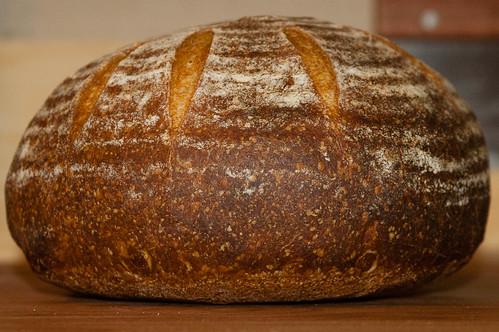
Volcanic boule, crust:
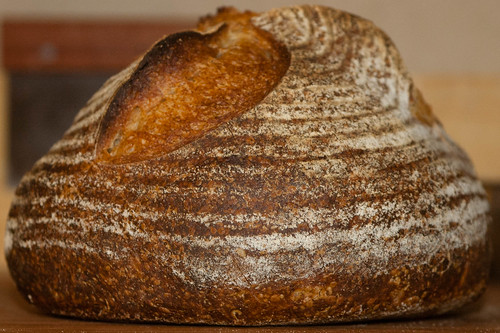
Cracklin’ crust:
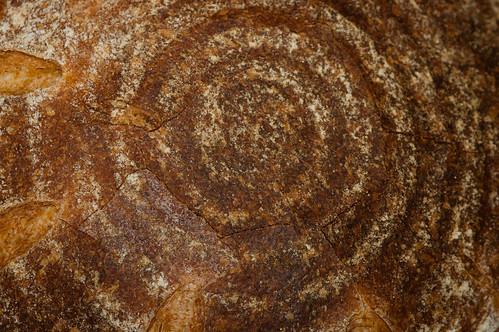
Cutting and Eating
3 hours later, I found that the under-proofed loaf had a more hollow sound to it—this gave me hope. I cut into both loaves to compare. I was successful in getting a less-thick crust, though they could perhaps be even thinner. On cutting, both loaves sent crumbs everywhere.
The crumb from the under-proofed loaf was too tight, but not as tight as I had feared it would be:

The volcanic loaf’s crumb showed the poorly channeled energy caused by the inappropriate scoring. You can see how the dough gasses were straining to make an escape:
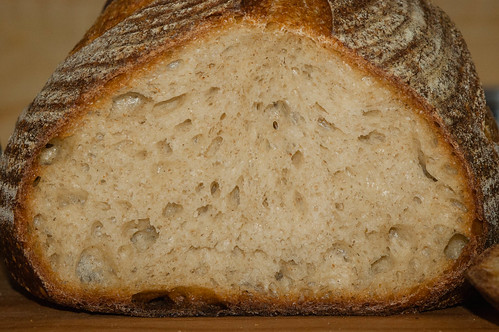
A closer view, showing the translucent, glossy holes from the long ferment:
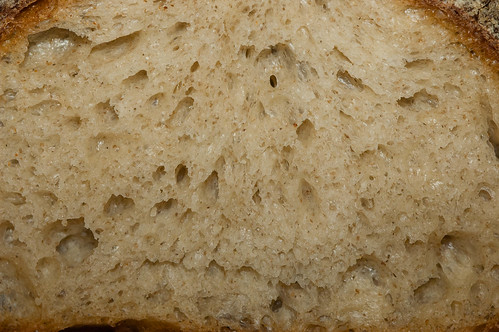
Both loaves are delicious. On the first day, there was little sense of sour. A nutty, earthy scent and flavor is predominant, with just the slightest tang beneath it. The mouth feel, even on the denser loaf, isn’t bad, and rather enjoyably chewy. The crust is a tad thick, but dark and full of flavor and crunchy rather than tough—at least for the first day.
Conclusion
I suspect that had I scored the proofed loaf with the straight radiating cuts I gave the under-proofed loaf, I would have had a nearly perfect loaf. I could be wrong, but will enjoy the one and only way of finding out.
I’m curious to see how the sour taste develops. On the first day I don’t notice much difference in the 3-stage build and the 1-stage build called for in the formula.
Questions
There are two things I’d like to learn more about—the autolyse and the bulk ferment. The purpose of the autolyse is to enhance extensibility. The instructions call for 20–60 minutes. How do I know how long to leave it? When is the autolyse done, and how will the dough feel at that time? And for the bulk ferment, I admit I slavishly follow the times given—how do I know when to shorten or prolong the bulk ferment time? How do I know when the dough has reached its maximum benefit from the bulk ferment?
[The Flickr photo gallery of this bake can be found here: http://www.flickr.com/photos/tuirgin/sets/72157631716753259/]
Percentages as printed in Bread, which do not quite work out for the amounts here.








 Before and after ingredient correction
Before and after ingredient correction


